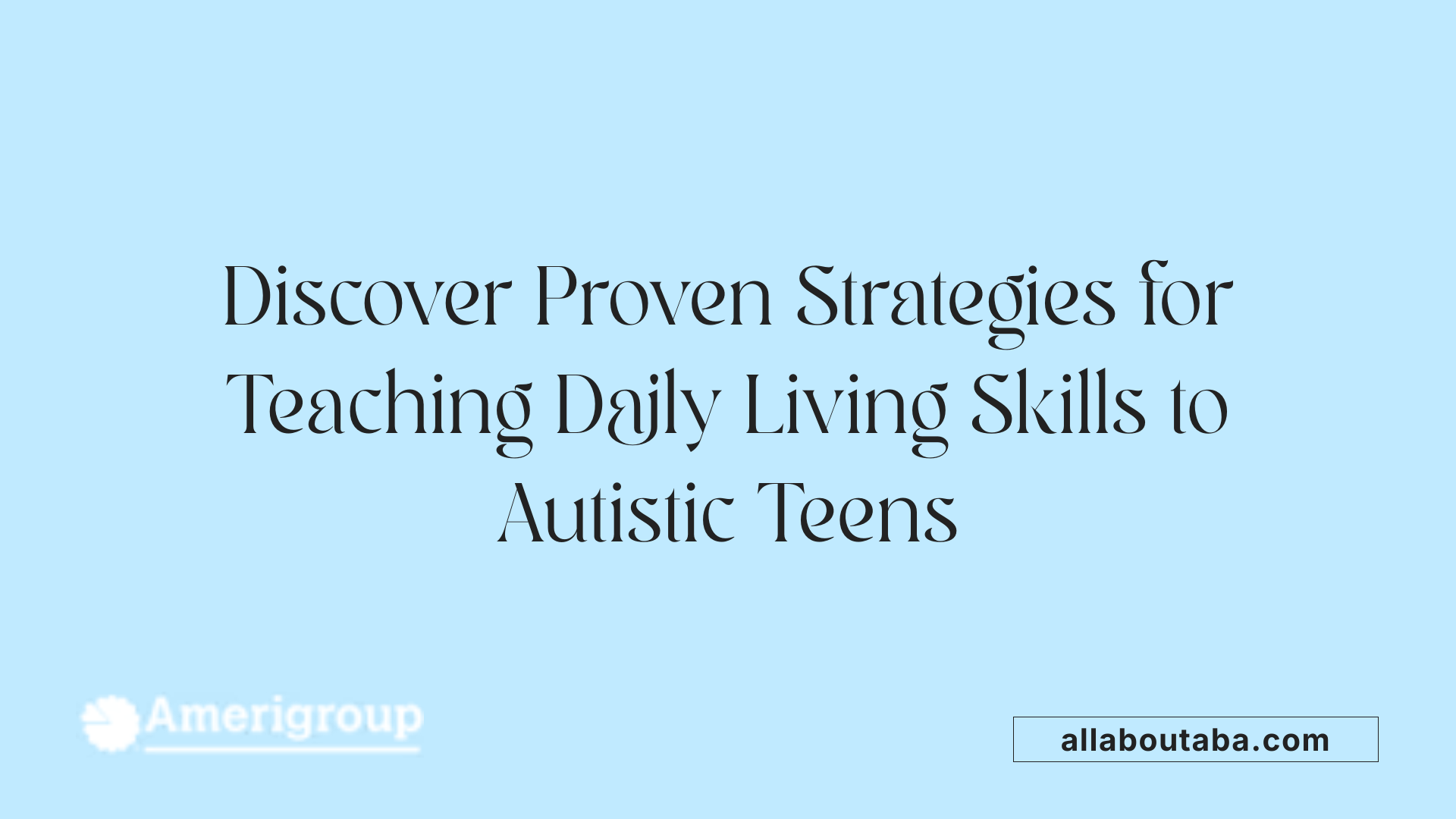Building independence for a brighter future
Teaching daily living skills to autistic teens is a crucial step in supporting their journey toward independence and self-sufficiency. As autistic individuals often face challenges in acquiring essential life skills, tailored interventions combining structured teaching methods and naturalistic practice can significantly enhance their capabilities. This article explores effective strategies, available resources, and practical tips for parents, caregivers, and professionals dedicated to fostering independence in autistic adolescents.
Understanding the Importance of Teaching Daily Living Skills
 Why developing independence and life skills is essential for autistic teens
Why developing independence and life skills is essential for autistic teens
Autistic teenagers often face challenges in developing skills necessary for independent living, and these difficulties can impact their ability to manage daily activities confidently. Teaching vital life skills such as self-care, cooking, managing money, shopping, and navigating transportation equips teens with the tools they need to handle real-world situations.
Research indicates that autistic teens tend to lag behind their peers in daily living abilities by six to eight years, regardless of IQ. This gap highlights the importance of early and targeted intervention. When life skills are introduced gradually and in natural environments, such as at home or in community settings, teens are more likely to generalize and retain these skills.
Structured teaching methods like task analysis, chaining, and visual supports (like pictures, checklists, and videos) are highly effective. These strategies help break down complex routines into manageable steps, making learning less overwhelming and more achievable. Reinforcing small successes, using prompts, and practicing skills repeatedly in different settings increase independence and confidence.
Developing executive functioning skills—such as planning, organization, and decision-making—is also crucial. These skills enable teens to coordinate daily routines, make choices, and solve problems, further fostering autonomy.
Often, support from professionals like occupational therapists and educators enhances skill acquisition. Vocational training and social programs also play a role by teaching job readiness, social cues, and self-esteem, preparing teens for adulthood.
Investing in life skills training not only promotes independence but also improves overall quality of life. It reduces reliance on caregivers, enhances safety, and encourages social participation, paving the way for a more autonomous future.
| Skill Area | Teaching Methods | Additional Resources |
|---|---|---|
| Self-care | Task analysis, visual schedules, prompts | Occupational therapy, social stories |
| Money management | Role-playing, visual checklists, real-world practice | Budgeting apps, financial literacy programs |
| Cooking and shopping | Step-by-step breakdowns, videos, checklists | Community-based nutrition classes |
| Transportation | Practice routes, visual cues, rehearsal | Community transit tutorials |
| Communication & social | Social skills groups, video modeling, role-play | Peer mentoring, social stories |
Supporting autistic teens in acquiring these skills fosters greater independence, enhances self-esteem, and prepares them for meaningful engagement in society. Tailoring instruction to individual needs, using visual aids, and practicing in authentic environments are essential components for success.
Strategies and Methods for Effective Teaching

What are effective strategies for teaching daily living skills to autistic teens?
Teaching daily living skills to autistic teenagers requires intentional, well-structured strategies tailored to each individual’s needs. Visual supports such as checklists, social stories, visual schedules, and videos play a vital role in helping teens understand and remember routines. These visual aids break down complex tasks into sequential, manageable steps, making learning more accessible.
A fundamental approach involves task analysis, which means dissecting activities like cooking, cleaning, or personal hygiene into smaller, teachable components. Chaining these steps—whether forward or backward—helps teens learn routines systematically. For example, starting with the last step in a routine often boosts motivation and provides a natural sense of accomplishment.
Consistent practice in natural settings, such as the home, community, or vocational environments, enhances skills' generalization. Incorporating real-life experiences like grocery shopping or using public transportation allows teens to apply what they learn and build confidence.
Repetition and positive reinforcement are critical for mastery. Offering praise, rewards, or preferred activities after successful attempts encourages continued effort and helps embed skills into daily life. Professional guidance from therapists or educators experienced with applied behavior analysis (ABA) or similar methods can optimize teaching approaches.
These strategies culminate in structured, engaging lessons tailored for each individual's developmental stage, fostering independence and preparing adolescents for adult life.
Resources and Educational Materials to Support Development
 Supporting autistic teens in gaining independence requires a variety of tailored resources and educational tools. Visual supports and assistive technologies play a crucial role in making complex routines manageable. Visual schedules, checklists, and social stories help break down tasks into simple, steps-based activities. Tools such as the Picture Exchange Communication System (PECS), speech output devices, and digital videos serve as effective methods to teach communication and daily living skills.
Supporting autistic teens in gaining independence requires a variety of tailored resources and educational tools. Visual supports and assistive technologies play a crucial role in making complex routines manageable. Visual schedules, checklists, and social stories help break down tasks into simple, steps-based activities. Tools such as the Picture Exchange Communication System (PECS), speech output devices, and digital videos serve as effective methods to teach communication and daily living skills.
Community-based assessments and curricula are vital to tailor instruction to each individual’s needs. These may include functional life skills assessments, which inform personalized programs focused on practical activities like cooking, shopping, money management, and navigating transportation systems.
Transition planning is another critical element. This involves curriculum-based instruction that emphasizes real-world experiences, aligning learning with future goals, and interests. Vocational training and community-based learning prepare teens for employment and active participation in society.
Organizations such as Autism Speaks and educational institutions offer a wealth of tools, programs, and curricula aimed at fostering independence. Resources like the Waterford curriculum or community assessment tools provide structured frameworks and activities for skill-building.
The use of technology further enhances learning. Video modeling and interactive apps simulate real-life situations, encouraging practice in a safe environment. This combination of visual tools, personalized curricula, and assistive devices ensures that autistic teens can develop the necessary confidence and skills for independent living.
In summary, combining visual supports, assistive technologies, community assessment tools, tailored curricula, and vocational programs creates a comprehensive support system. These resources enable teens to master essential life skills, ultimately fostering greater independence and improving quality of life.
Practical Tips and Step-by-Step Guidance for Parents and Caregivers

What are some practical tips and step-by-step methods for parents and caregivers to teach life skills to autistic adolescents?
Teaching life skills to autistic adolescents requires a tailored approach that considers individual needs and developmental levels. To start, conduct an informal assessment to pinpoint skills your child already has and what areas need improvement. This helps set realistic, achievable goals.
Using visual aids plays a vital role. Visual supports such as schedules, checklists, and task analyses break down complex routines into small, manageable steps. These tools not only clarify expectations but also boost confidence and independence.
Teaching strategies like modeling, role-playing, and video modeling are effective. Show your child how to perform tasks step-by-step, encouraging imitation. For example, demonstrate how to make a simple lunch or use visual prompts to guide them through daily routines.
Chaining techniques, such as forward or backward chaining, involve teaching one step at a time and linking them together until the full task is mastered. Often, starting with the last step in a task increases motivation because it provides a natural reward, encouraging continued participation.
Repetition and practice in natural environments—like the kitchen, bathroom, or community—are key to ensuring skills generalize across settings. Regular practice consolidates learning and helps your child become more autonomous.
Effective communication support, including social stories and visual cues, can enhance understanding and social interaction. These tools help your child grasp social cues and expectations related to daily activities.
Finally, positive reinforcement is crucial. Celebrate small successes with praise or rewards, and maintain consistent routines to provide stability and predictability. Adjust your environment to support independence by removing unnecessary distractions and creating inviting spaces for learning.
Incorporating these strategies creates a supportive structure that promotes the development of essential life skills, boosting your child's confidence and readiness for greater independence.
Assessing and Improving Daily Living Skills

How can caregivers assess and improve daily living skills in autistic adolescents?
Evaluating and developing daily living skills in autistic teens requires a combination of formal assessments and everyday observations. Professionals often use tools like the Community-Based Skills Assessment (CSA) and performance-based measures such as the Comprehensive Functional Skills Assessment Tool (CFSAT). These assessments help identify specific skills in real-world tasks, including self-care, cooking, and money management.
In addition to formal testing, informal observations are vital. Caregivers and teachers observe how teens handle routines, social interactions, and practical activities in natural settings. This ongoing assessment guides tailored interventions.
To promote skill acquisition, visual cues like checklists, charts, and schedules are invaluable. Breaking down complex routines into smaller, manageable steps—using task analysis—makes learning easier. Visual supports, including pictures and videos, can reinforce understanding and independence.
Practice in realistic environments is essential. Repeating activities at home, in the community, or through virtual simulations helps teens generalize skills beyond structured settings. Incorporating real-world practice is crucial for preparing adolescents to navigate daily life confidently.
Monitoring progress regularly allows caregivers and therapists to adjust strategies as needed. As teens develop their abilities, interventions can be modified to maintain motivation, encourage independence, and address emerging challenges. Occupational therapists often collaborate with families to provide personalized plans that foster continuous growth.
Ultimately, consistent assessment coupled with tailored teaching methods and practical experience supports autistic adolescents in gaining vital life skills, empowering them for a more independent future.
Fostering Independence and Self-Esteem
Supporting autistic teens in acquiring daily living skills requires a comprehensive, individualized approach that combines structured teaching strategies, visual supports, real-life practice, and ongoing assessment. Early intervention and consistent reinforcement are key to enhancing independence. Utilizing available resources, engaging professionals, and tailoring instruction to each teen’s needs can empower them to navigate daily life confidently, leading to greater independence, improved quality of life, and successful integration into the community. Ultimately, fostering these skills not only benefits the teens themselves but also enriches their families and communities by promoting self-sufficiency and confidence.
References
- Life skills for autism
- Daily Living Skills: A Key to Independence for People with ...
- Helping Autistic Teens Build Independence and Life Skills
- 11 Tips for Teaching Activities of Daily Living
- Teaching daily living skills to children with autism in ...
- Everyday skills for autistic children and teenagers
- Life Skills
- Life Skills Programs







